Critical Analysis: ADHD Neurofeedback Treatment and Fallacies
VerifiedAdded on 2022/09/02
|5
|1342
|35
Report
AI Summary
This report presents a critical analysis of an article titled "ADHD Neurofeedback: helping your children to stay focused!". The article discusses the treatment of Attention Deficit Hyperactivity Disorder (ADHD) in children through neurofeedback, a technique that aims to alter brain waves to improve focus and reduce hyperactivity and impulsivity. The report evaluates the claims made in the article, highlighting both the potential benefits, such as the absence of drug side effects, and the limitations, including the possibility of a placebo effect and the lack of sufficient evidence to support some claims. The analysis identifies instances of the appeal to authority and hasty generalization fallacies, concluding that the article provides a one-sided perspective. While acknowledging the potential of neurofeedback, the report emphasizes the need for further research and a broader consideration of alternative treatment approaches like therapy and counseling. The report also highlights the article's bias due to its source being a company promoting neurofeedback technology.
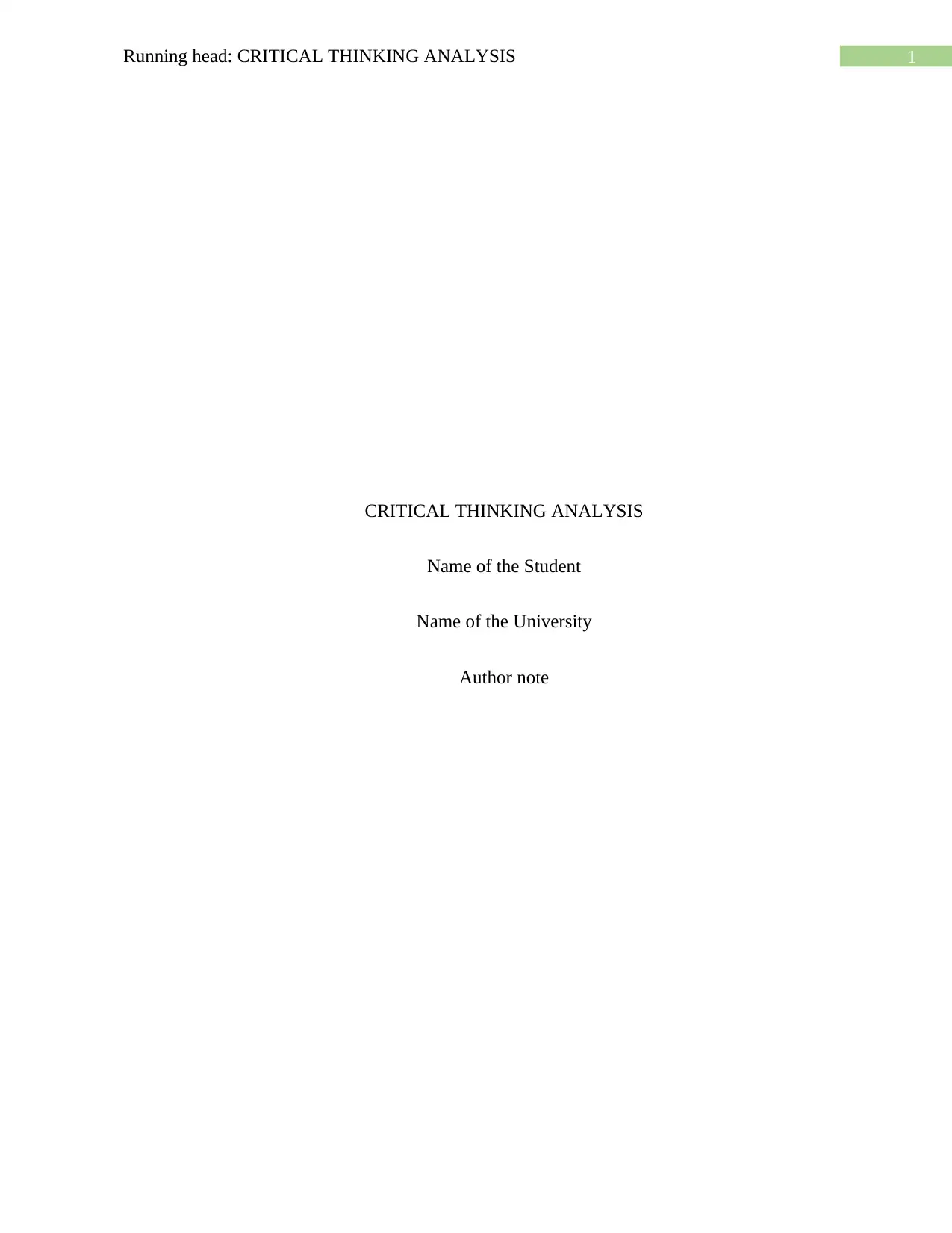
1Running head: CRITICAL THINKING ANALYSIS
CRITICAL THINKING ANALYSIS
Name of the Student
Name of the University
Author note
CRITICAL THINKING ANALYSIS
Name of the Student
Name of the University
Author note
Paraphrase This Document
Need a fresh take? Get an instant paraphrase of this document with our AI Paraphraser
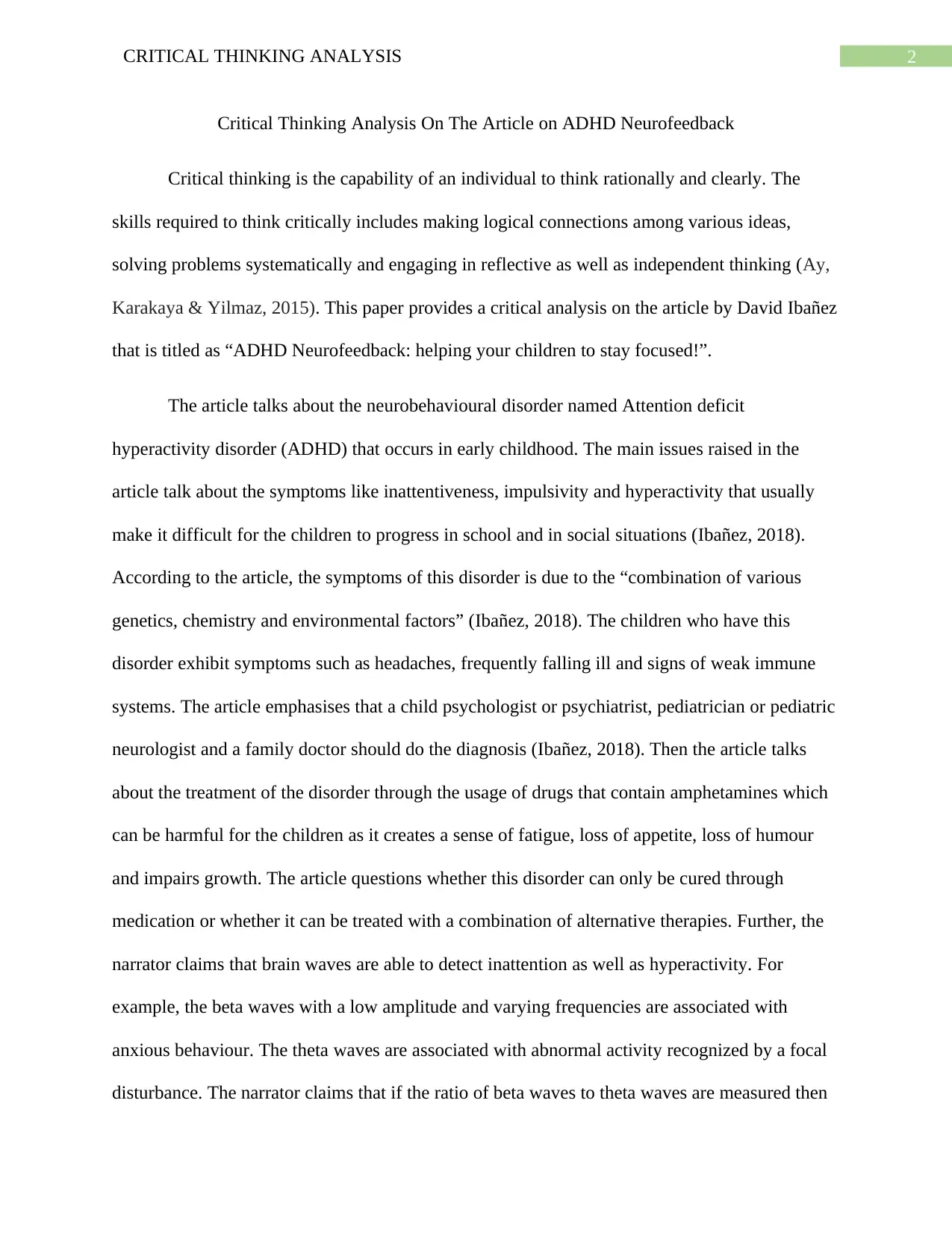
2CRITICAL THINKING ANALYSIS
Critical Thinking Analysis On The Article on ADHD Neurofeedback
Critical thinking is the capability of an individual to think rationally and clearly. The
skills required to think critically includes making logical connections among various ideas,
solving problems systematically and engaging in reflective as well as independent thinking (Ay,
Karakaya & Yilmaz, 2015). This paper provides a critical analysis on the article by David Ibañez
that is titled as “ADHD Neurofeedback: helping your children to stay focused!”.
The article talks about the neurobehavioural disorder named Attention deficit
hyperactivity disorder (ADHD) that occurs in early childhood. The main issues raised in the
article talk about the symptoms like inattentiveness, impulsivity and hyperactivity that usually
make it difficult for the children to progress in school and in social situations (Ibañez, 2018).
According to the article, the symptoms of this disorder is due to the “combination of various
genetics, chemistry and environmental factors” (Ibañez, 2018). The children who have this
disorder exhibit symptoms such as headaches, frequently falling ill and signs of weak immune
systems. The article emphasises that a child psychologist or psychiatrist, pediatrician or pediatric
neurologist and a family doctor should do the diagnosis (Ibañez, 2018). Then the article talks
about the treatment of the disorder through the usage of drugs that contain amphetamines which
can be harmful for the children as it creates a sense of fatigue, loss of appetite, loss of humour
and impairs growth. The article questions whether this disorder can only be cured through
medication or whether it can be treated with a combination of alternative therapies. Further, the
narrator claims that brain waves are able to detect inattention as well as hyperactivity. For
example, the beta waves with a low amplitude and varying frequencies are associated with
anxious behaviour. The theta waves are associated with abnormal activity recognized by a focal
disturbance. The narrator claims that if the ratio of beta waves to theta waves are measured then
Critical Thinking Analysis On The Article on ADHD Neurofeedback
Critical thinking is the capability of an individual to think rationally and clearly. The
skills required to think critically includes making logical connections among various ideas,
solving problems systematically and engaging in reflective as well as independent thinking (Ay,
Karakaya & Yilmaz, 2015). This paper provides a critical analysis on the article by David Ibañez
that is titled as “ADHD Neurofeedback: helping your children to stay focused!”.
The article talks about the neurobehavioural disorder named Attention deficit
hyperactivity disorder (ADHD) that occurs in early childhood. The main issues raised in the
article talk about the symptoms like inattentiveness, impulsivity and hyperactivity that usually
make it difficult for the children to progress in school and in social situations (Ibañez, 2018).
According to the article, the symptoms of this disorder is due to the “combination of various
genetics, chemistry and environmental factors” (Ibañez, 2018). The children who have this
disorder exhibit symptoms such as headaches, frequently falling ill and signs of weak immune
systems. The article emphasises that a child psychologist or psychiatrist, pediatrician or pediatric
neurologist and a family doctor should do the diagnosis (Ibañez, 2018). Then the article talks
about the treatment of the disorder through the usage of drugs that contain amphetamines which
can be harmful for the children as it creates a sense of fatigue, loss of appetite, loss of humour
and impairs growth. The article questions whether this disorder can only be cured through
medication or whether it can be treated with a combination of alternative therapies. Further, the
narrator claims that brain waves are able to detect inattention as well as hyperactivity. For
example, the beta waves with a low amplitude and varying frequencies are associated with
anxious behaviour. The theta waves are associated with abnormal activity recognized by a focal
disturbance. The narrator claims that if the ratio of beta waves to theta waves are measured then
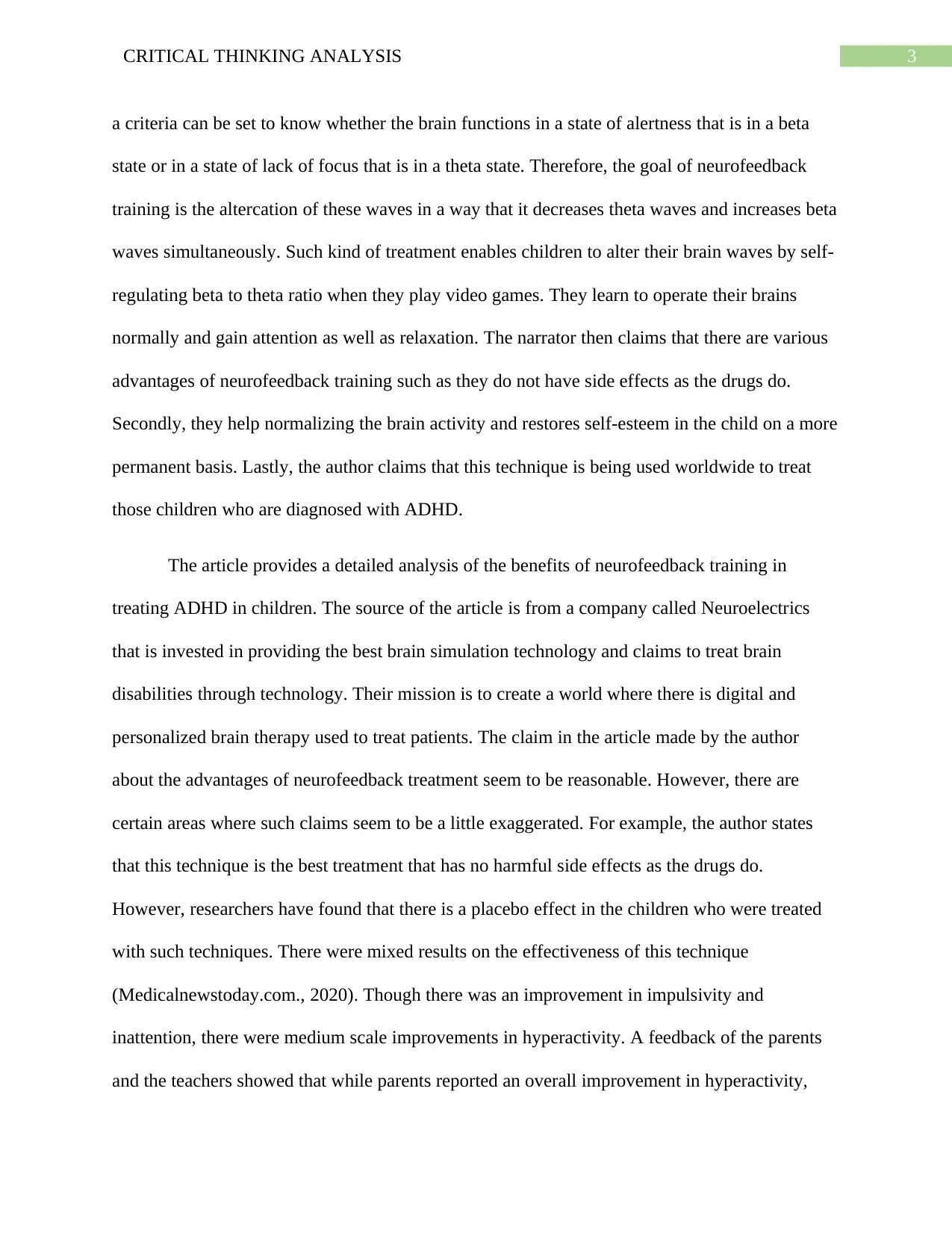
3CRITICAL THINKING ANALYSIS
a criteria can be set to know whether the brain functions in a state of alertness that is in a beta
state or in a state of lack of focus that is in a theta state. Therefore, the goal of neurofeedback
training is the altercation of these waves in a way that it decreases theta waves and increases beta
waves simultaneously. Such kind of treatment enables children to alter their brain waves by self-
regulating beta to theta ratio when they play video games. They learn to operate their brains
normally and gain attention as well as relaxation. The narrator then claims that there are various
advantages of neurofeedback training such as they do not have side effects as the drugs do.
Secondly, they help normalizing the brain activity and restores self-esteem in the child on a more
permanent basis. Lastly, the author claims that this technique is being used worldwide to treat
those children who are diagnosed with ADHD.
The article provides a detailed analysis of the benefits of neurofeedback training in
treating ADHD in children. The source of the article is from a company called Neuroelectrics
that is invested in providing the best brain simulation technology and claims to treat brain
disabilities through technology. Their mission is to create a world where there is digital and
personalized brain therapy used to treat patients. The claim in the article made by the author
about the advantages of neurofeedback treatment seem to be reasonable. However, there are
certain areas where such claims seem to be a little exaggerated. For example, the author states
that this technique is the best treatment that has no harmful side effects as the drugs do.
However, researchers have found that there is a placebo effect in the children who were treated
with such techniques. There were mixed results on the effectiveness of this technique
(Medicalnewstoday.com., 2020). Though there was an improvement in impulsivity and
inattention, there were medium scale improvements in hyperactivity. A feedback of the parents
and the teachers showed that while parents reported an overall improvement in hyperactivity,
a criteria can be set to know whether the brain functions in a state of alertness that is in a beta
state or in a state of lack of focus that is in a theta state. Therefore, the goal of neurofeedback
training is the altercation of these waves in a way that it decreases theta waves and increases beta
waves simultaneously. Such kind of treatment enables children to alter their brain waves by self-
regulating beta to theta ratio when they play video games. They learn to operate their brains
normally and gain attention as well as relaxation. The narrator then claims that there are various
advantages of neurofeedback training such as they do not have side effects as the drugs do.
Secondly, they help normalizing the brain activity and restores self-esteem in the child on a more
permanent basis. Lastly, the author claims that this technique is being used worldwide to treat
those children who are diagnosed with ADHD.
The article provides a detailed analysis of the benefits of neurofeedback training in
treating ADHD in children. The source of the article is from a company called Neuroelectrics
that is invested in providing the best brain simulation technology and claims to treat brain
disabilities through technology. Their mission is to create a world where there is digital and
personalized brain therapy used to treat patients. The claim in the article made by the author
about the advantages of neurofeedback treatment seem to be reasonable. However, there are
certain areas where such claims seem to be a little exaggerated. For example, the author states
that this technique is the best treatment that has no harmful side effects as the drugs do.
However, researchers have found that there is a placebo effect in the children who were treated
with such techniques. There were mixed results on the effectiveness of this technique
(Medicalnewstoday.com., 2020). Though there was an improvement in impulsivity and
inattention, there were medium scale improvements in hyperactivity. A feedback of the parents
and the teachers showed that while parents reported an overall improvement in hyperactivity,
⊘ This is a preview!⊘
Do you want full access?
Subscribe today to unlock all pages.

Trusted by 1+ million students worldwide
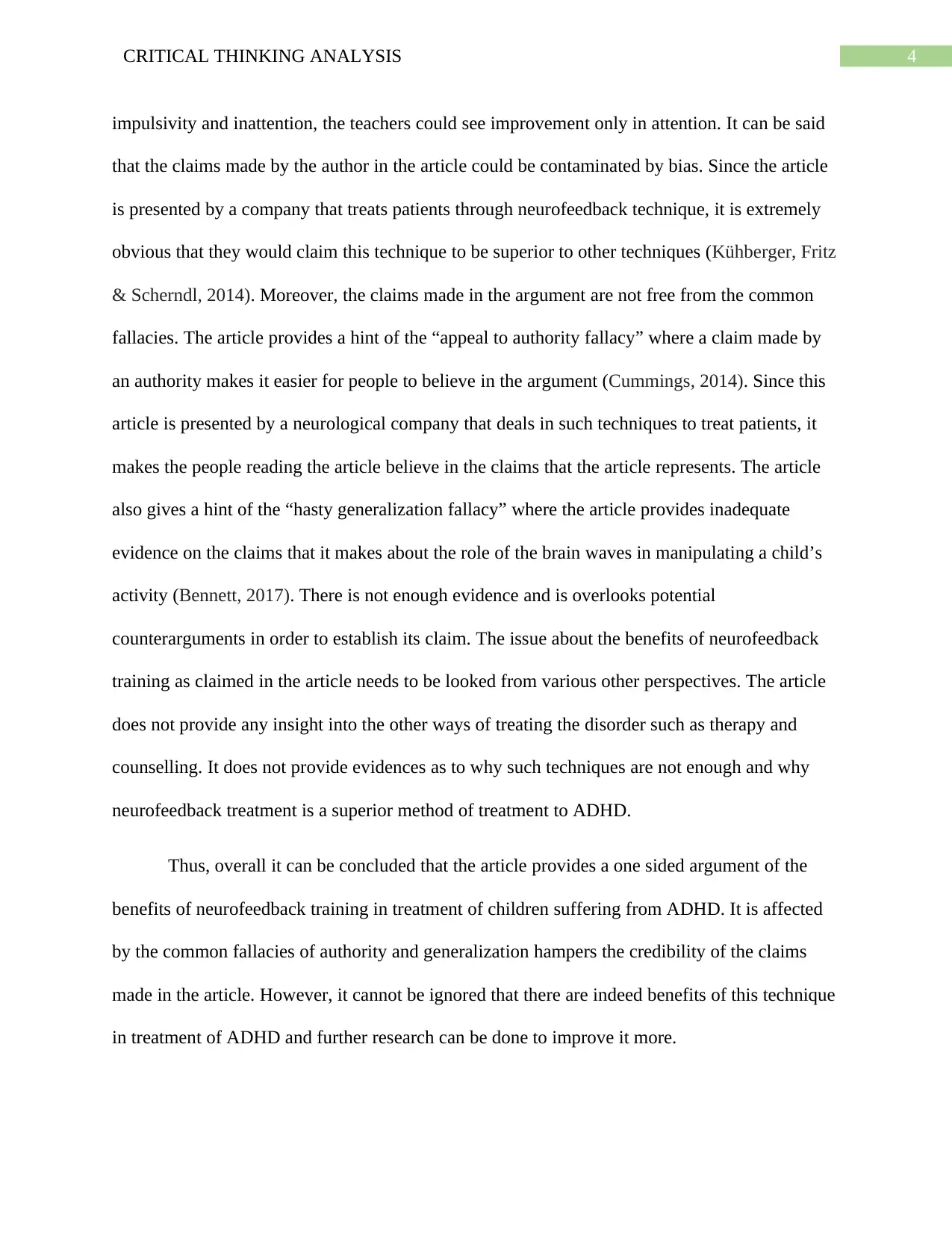
4CRITICAL THINKING ANALYSIS
impulsivity and inattention, the teachers could see improvement only in attention. It can be said
that the claims made by the author in the article could be contaminated by bias. Since the article
is presented by a company that treats patients through neurofeedback technique, it is extremely
obvious that they would claim this technique to be superior to other techniques (Kühberger, Fritz
& Scherndl, 2014). Moreover, the claims made in the argument are not free from the common
fallacies. The article provides a hint of the “appeal to authority fallacy” where a claim made by
an authority makes it easier for people to believe in the argument (Cummings, 2014). Since this
article is presented by a neurological company that deals in such techniques to treat patients, it
makes the people reading the article believe in the claims that the article represents. The article
also gives a hint of the “hasty generalization fallacy” where the article provides inadequate
evidence on the claims that it makes about the role of the brain waves in manipulating a child’s
activity (Bennett, 2017). There is not enough evidence and is overlooks potential
counterarguments in order to establish its claim. The issue about the benefits of neurofeedback
training as claimed in the article needs to be looked from various other perspectives. The article
does not provide any insight into the other ways of treating the disorder such as therapy and
counselling. It does not provide evidences as to why such techniques are not enough and why
neurofeedback treatment is a superior method of treatment to ADHD.
Thus, overall it can be concluded that the article provides a one sided argument of the
benefits of neurofeedback training in treatment of children suffering from ADHD. It is affected
by the common fallacies of authority and generalization hampers the credibility of the claims
made in the article. However, it cannot be ignored that there are indeed benefits of this technique
in treatment of ADHD and further research can be done to improve it more.
impulsivity and inattention, the teachers could see improvement only in attention. It can be said
that the claims made by the author in the article could be contaminated by bias. Since the article
is presented by a company that treats patients through neurofeedback technique, it is extremely
obvious that they would claim this technique to be superior to other techniques (Kühberger, Fritz
& Scherndl, 2014). Moreover, the claims made in the argument are not free from the common
fallacies. The article provides a hint of the “appeal to authority fallacy” where a claim made by
an authority makes it easier for people to believe in the argument (Cummings, 2014). Since this
article is presented by a neurological company that deals in such techniques to treat patients, it
makes the people reading the article believe in the claims that the article represents. The article
also gives a hint of the “hasty generalization fallacy” where the article provides inadequate
evidence on the claims that it makes about the role of the brain waves in manipulating a child’s
activity (Bennett, 2017). There is not enough evidence and is overlooks potential
counterarguments in order to establish its claim. The issue about the benefits of neurofeedback
training as claimed in the article needs to be looked from various other perspectives. The article
does not provide any insight into the other ways of treating the disorder such as therapy and
counselling. It does not provide evidences as to why such techniques are not enough and why
neurofeedback treatment is a superior method of treatment to ADHD.
Thus, overall it can be concluded that the article provides a one sided argument of the
benefits of neurofeedback training in treatment of children suffering from ADHD. It is affected
by the common fallacies of authority and generalization hampers the credibility of the claims
made in the article. However, it cannot be ignored that there are indeed benefits of this technique
in treatment of ADHD and further research can be done to improve it more.
Paraphrase This Document
Need a fresh take? Get an instant paraphrase of this document with our AI Paraphraser
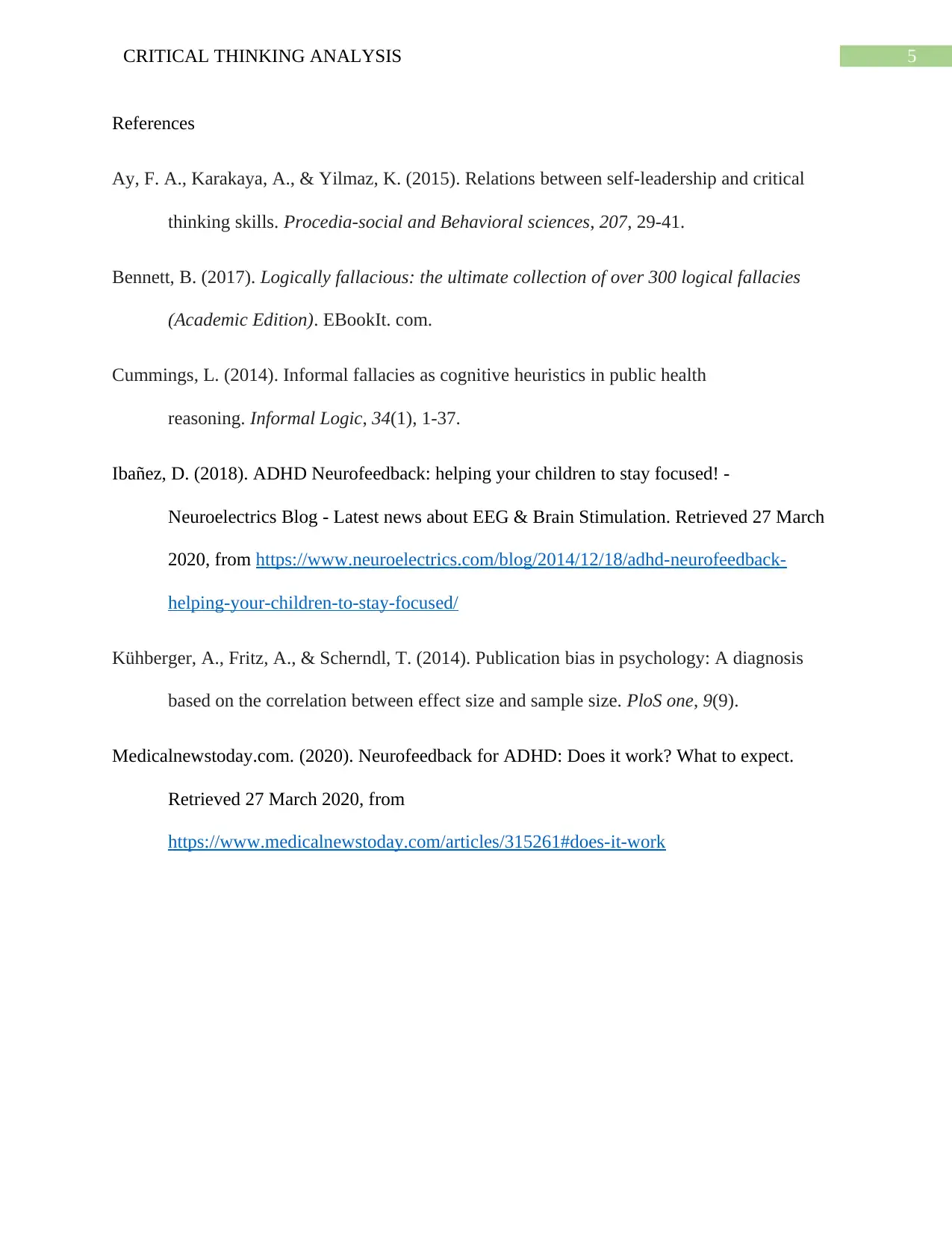
5CRITICAL THINKING ANALYSIS
References
Ay, F. A., Karakaya, A., & Yilmaz, K. (2015). Relations between self-leadership and critical
thinking skills. Procedia-social and Behavioral sciences, 207, 29-41.
Bennett, B. (2017). Logically fallacious: the ultimate collection of over 300 logical fallacies
(Academic Edition). EBookIt. com.
Cummings, L. (2014). Informal fallacies as cognitive heuristics in public health
reasoning. Informal Logic, 34(1), 1-37.
Ibañez, D. (2018). ADHD Neurofeedback: helping your children to stay focused! -
Neuroelectrics Blog - Latest news about EEG & Brain Stimulation. Retrieved 27 March
2020, from https://www.neuroelectrics.com/blog/2014/12/18/adhd-neurofeedback-
helping-your-children-to-stay-focused/
Kühberger, A., Fritz, A., & Scherndl, T. (2014). Publication bias in psychology: A diagnosis
based on the correlation between effect size and sample size. PloS one, 9(9).
Medicalnewstoday.com. (2020). Neurofeedback for ADHD: Does it work? What to expect.
Retrieved 27 March 2020, from
https://www.medicalnewstoday.com/articles/315261#does-it-work
References
Ay, F. A., Karakaya, A., & Yilmaz, K. (2015). Relations between self-leadership and critical
thinking skills. Procedia-social and Behavioral sciences, 207, 29-41.
Bennett, B. (2017). Logically fallacious: the ultimate collection of over 300 logical fallacies
(Academic Edition). EBookIt. com.
Cummings, L. (2014). Informal fallacies as cognitive heuristics in public health
reasoning. Informal Logic, 34(1), 1-37.
Ibañez, D. (2018). ADHD Neurofeedback: helping your children to stay focused! -
Neuroelectrics Blog - Latest news about EEG & Brain Stimulation. Retrieved 27 March
2020, from https://www.neuroelectrics.com/blog/2014/12/18/adhd-neurofeedback-
helping-your-children-to-stay-focused/
Kühberger, A., Fritz, A., & Scherndl, T. (2014). Publication bias in psychology: A diagnosis
based on the correlation between effect size and sample size. PloS one, 9(9).
Medicalnewstoday.com. (2020). Neurofeedback for ADHD: Does it work? What to expect.
Retrieved 27 March 2020, from
https://www.medicalnewstoday.com/articles/315261#does-it-work
1 out of 5
Your All-in-One AI-Powered Toolkit for Academic Success.
+13062052269
info@desklib.com
Available 24*7 on WhatsApp / Email
![[object Object]](/_next/static/media/star-bottom.7253800d.svg)
Unlock your academic potential
Copyright © 2020–2025 A2Z Services. All Rights Reserved. Developed and managed by ZUCOL.
